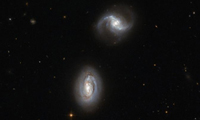SpaceMath@NASA Activities
If you have middle school/high school visitors SpaceMath@NASA introduces students to the use of mathematics in today's scientific discoveries. Through press releases and articles, Space Math explores how many kinds of mathematics skills come together in exploring the Universe. If you have a math club, the following problems might be fun for them to try in connection with the Light exhibit:
Problem 553:Colliding Galaxies - The future of our Milky Way
Students explore the collision of two galaxies and estimate from their present speed, separation and acceleration how long it will be before they have collided. [Grade: 9-12 | Topics: unit conversions; scientific notation; ballistic equation; solving quadratic equations]
(PDF)
Students explore the collision of two galaxies and estimate from their present speed, separation and acceleration how long it will be before they have collided. [Grade: 9-12 | Topics: unit conversions; scientific notation; ballistic equation; solving quadratic equations]
(PDF)
Problem 564:Exploring the Stars in Orion - Light Year Madness
Students explore the light year and its relationship to light travel time for observing events in different parts of space.When would colonists at different locations observe the star Betelgeuse become a supernova? [Grade: 6-8 | Topics: time lines; time interval calculations; time = distance/speed ]
(PDF)
Students explore the light year and its relationship to light travel time for observing events in different parts of space.When would colonists at different locations observe the star Betelgeuse become a supernova? [Grade: 6-8 | Topics: time lines; time interval calculations; time = distance/speed ]
(PDF)
Problem 570: Curiosity Heads for Mt Sharp
Tabular data is used to estimate how long it will take the Curiosity rover to reach the base of Mt Sharp using data from its porevious week travels. [Grade: 3-5 | Topics: averaging numbers in a table; time = distance/speed]
(PDF)
Tabular data is used to estimate how long it will take the Curiosity rover to reach the base of Mt Sharp using data from its porevious week travels. [Grade: 3-5 | Topics: averaging numbers in a table; time = distance/speed]
(PDF)
Problem 680:A Pulsar Shot Out from a Supernova Explosion!
Students study the speed of a pulsar ejected from a supernova explosion, and describe what would happen if the dense star collided with a star like the sun. [Grade: 6-8 | Topics: Scientific notation; speed=distance/time; unit conversions; density ]
(PDF)
Students study the speed of a pulsar ejected from a supernova explosion, and describe what would happen if the dense star collided with a star like the sun. [Grade: 6-8 | Topics: Scientific notation; speed=distance/time; unit conversions; density ]
(PDF)








